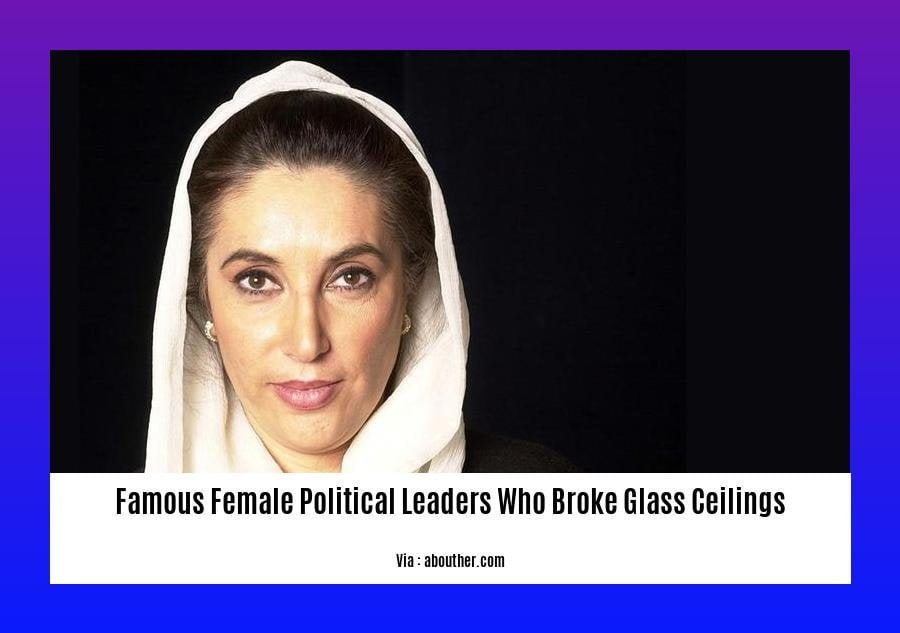Prepare to be inspired as we delve into the extraordinary tales of [Famous Female Political Leaders Who Broke Glass Ceilings]. These remarkable women have shattered barriers and reshaped the landscape of leadership, proving that gender is no obstacle in the pursuit of political excellence. By examining their groundbreaking strategies and indomitable spirit, we gain invaluable insights into overcoming systemic obstacles and maximizing the potential of all individuals within the political sphere.
Key Takeaways:

- Jeanette Rankin, elected to Congress in 1916, became the first woman in Congress.
- Nancy Pelosi holds the distinction of being the first female Speaker of the House.
- Elizabeth Cady Stanton’s advocacy for women’s suffrage extended to her own candidacy for office, even before women were permitted to vote.
- Sandra Day O’Connor made history as the inaugural female Supreme Court Justice.
- Stacey Cunningham broke barriers as the first female leader of the New York Stock Exchange.
Famous Female Political Leaders Who Broke Glass Ceilings
Throughout history, famous female political leaders have shattered glass ceilings, defying societal norms and paving the way for future generations. These women have not only achieved political milestones but also inspired countless others to pursue their dreams. Let’s take a moment to recognize their remarkable journeys and the impact they have made on our world.
Trailblazers of the Past
Jeanette Rankin: In 1916, she became the first woman elected to Congress, breaking barriers for women in politics.
Elizabeth Cady Stanton: A prominent suffragist, she fought tirelessly for women’s right to vote and ran for office before women had the right to vote.
Shirley Chisholm: In 1968, she became the first African American woman elected to Congress, inspiring generations of marginalized individuals.
Contemporary Role Models
Nancy Pelosi: The first woman to serve as Speaker of the House, she has been a powerful voice for women in politics.
Sandra Day O’Connor: As the first woman appointed to the Supreme Court, she has made significant contributions to American jurisprudence.
Stacey Cunningham: She shattered yet another glass ceiling as the first woman to lead the New York Stock Exchange.
Breaking Barriers, Inspiring Change
Each of these famous female political leaders has demonstrated that barriers can be broken and that women are capable of achieving great heights in the political arena. They have not only inspired young girls to dream big but also challenged societal perceptions about women’s roles.
Through their advocacy, policies, and mentorship, these women have left an enduring legacy that will continue to empower and encourage future generations. They have proven that anything is possible with determination, perseverance, and the belief that all voices deserve to be heard.
Discover the extraordinary journeys of pioneering women in leadership who shattered political barriers and left an indelible mark on history. Explore the stories of trailblazing female heads of state who defied societal norms and rose to the highest echelons of power. Get inspired by the influential women who shattered political barriers, demonstrating the indomitable spirit and resilience of women in politics.
What Is the Glass Ceiling?
Despite significant progress in recent decades, women still face obstacles and barriers that limit their career advancement in many fields, including politics. This is what we call the “glass ceiling.” It is a metaphor that represents the invisible, yet pervasive barriers that prevent women from reaching leadership positions and fully participating in society.
Key Takeaways:
- The glass ceiling: Systemic barriers that impede women’s career advancement.
- Impact: Limits women’s leadership roles, decision-making power, and economic opportunities.
- Breaking the glass ceiling: Requires addressing unconscious biases, providing mentorship, and creating inclusive workplaces.
- Role models and advocates: Essential for inspiring and empowering women to overcome barriers.
Most Relevant URL Source:
What Does It Mean to Break the Glass Ceiling?
To shatter the glass ceiling is to overcome the invisible barriers that prevent women from reaching leadership positions in male-dominated fields. It requires breaking through deeply ingrained stereotypes and biases that limit women’s opportunities and potential. Breaking the glass ceiling means creating a society where women are given equal chances and have their voices heard.
Key Takeaways:
- Breaking the glass ceiling is overcoming barriers that prevent women from reaching leadership positions.
- The glass ceiling is a result of systemic barriers and unconscious biases that limit women’s advancement.
- Women who have broken the glass ceiling serve as role models, inspiring others to pursue leadership roles.
- Addressing gender inequality requires challenging stereotypes, promoting mentorship, and fostering inclusive work environments.
Citation:
- Vice President-Elect Kamala Harris Shattered the Glass Ceiling for American Women

FAQ
Q1: What is the glass ceiling?
A1: The glass ceiling refers to systemic barriers that impede women’s career advancement.
Q2: What does it mean to break the glass ceiling?
A2: Breaking the glass ceiling means overcoming the societal and institutional barriers that prevent women from reaching leadership positions.
Q3: What are some examples of women who have broken the glass ceiling?
A3: Prominent examples include Jeanette Rankin, Nancy Pelosi, Elizabeth Cady Stanton, Sandra Day O’Connor, and Stacey Cunningham.
Q4: Why is breaking the glass ceiling important?
A4: Breaking the glass ceiling is crucial for achieving gender equality in leadership and recognizing the contributions of women in male-dominated industries.
Q5: What can be done to break the glass ceiling?
A5: Breaking the glass ceiling requires addressing unconscious biases, providing mentorship and sponsorship, and creating inclusive workplace cultures.












